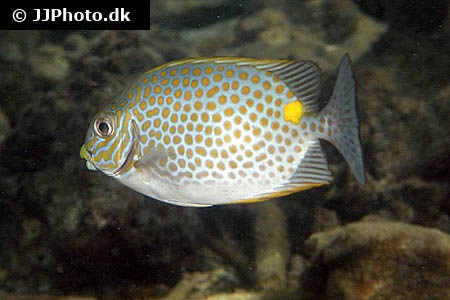Siganus guttatus


| Latin name | Siganus guttatus - (Bloch, 1787) |
|---|---|
| Local name | Goldlined spinefoot |
| Family | Siganidae - Siganus |
| Origin | East Indian Ocean, Australia, Japan, Indonesia, Central/West Pacific |
| Max length | 42 cm (16.5") |
| Minimum volume |
1200 l (317 gal) |
|---|---|
| Hardiness |
Hardy |
| Suitable for aquarium |
Suitable for most aquarium |
| Reef safe |
Often reef safe |
| Aggressiveness | Mostly peaceful but might be aggressive towards similar species |
| Recommended |
Macroalgea (Eg. seaweed / nori) Microalgea (Eg. spirulina) |
|---|---|
| Mostly |
Small crustaceans (Krill, mysis, artemia...) |
| Maybee |
Large polyp stone coral (LPS) Soft coral |
This species is venomous, but it´s toxin is rarely dangerous to humans. It can however cause considerable pain.
In case of poisoning it is vital to have as much information as possible regarding the species/poison. Have telephone numbers for the poison hotline close to the aquarium.
Since different people can have different reactions to poisons, take precautions necessary to ensure personal safety and that of the surroundings.
This poison can be dangerous if suffering from allergies.
This species can be found nibbling soft coral and LPS if there is insufficient food available.
These fish should be kept in a well run aquarium where they can "graze" algae from rocks and stones.
If there are insufficient algae on the rocks, it is important to feed more frequently and supplement with algae rich food e.g. Spirulina.
They can live as a pair provided they are introduced simultaneously.
This species revels in swimming and requires an aquarium with ample space.
This species changes colour when afraid.
Typically, they become pale or brownish.
This species can eat large amounts of algae (relative to their size) from rocks, like green hair algae and filamentous algae.
As it doesn’t eat every algae type, in case of a specific algae plague, find out more precise information.
Even though these fish enjoy a diverse type of frozen foods, it is imperative that its primary food, is algae based, thus ensuring that the fish`s immune system remains healthy.
This can, for example, be plant based fish flakes, Nori seaweed or similar.
Rabbit fish (siganidae) are known for being effective algae eaters.
These fish are often used to fight bubble algae, which can otherwise be hard to remove.
It can be challenging to keep them well fed, if there is not sufficient algae in the aquarium.
They all have toxic spines on their backs, therefore be cautious, although they will mostly swim away and hide, when your hands are in the aquarium. If these fish feel threatened they will hide next to a rock and change colour and pattern. They can appear "ill", but this is their natural camouflage
These fish are not suitable for small aquaria, as they can end up swimming around in the same circle all day long.
| Aquarium trade | Yes |
|---|---|
| Distribution | Eastern Indian Ocean and Western Pacific: Andaman Islands, Thailand, Malaysia, Singapore, Indonesia (including Irian Jaya), Viet Nam, Ryukyus, southern and eastern China, Taiwan, South China Sea, Philippines, and Palau. Replaced by Siganus lineatus |
| English common names |
Gold-saddle rabbitfish Golden rabbit fish Goldenspotted spinefoot Golden rabbitfish Orange-spotted spinefoot |
| Danish common names |
Orangeplettet kaninfisk |
James W. Fatherree. 2013. Aquarium Fish: Fishes of the Genus Siganus: The Rabbitfishes - Advanced Aquarist - (English)
Jeff Kurtz. 2007. A Warren of Righteous Rabbitfishes - Tropical Fish Hobbyist Magazine - (English)
Bob Fenner. The Fishes We Call Rabbits, Family Siganidae - Wet Web Media - (English)

